 FREE SHIPPING on US orders over $150. Need help? Contact Us
FREE SHIPPING on US orders over $150. Need help? Contact Us Genuine Tourmaline Gemstones
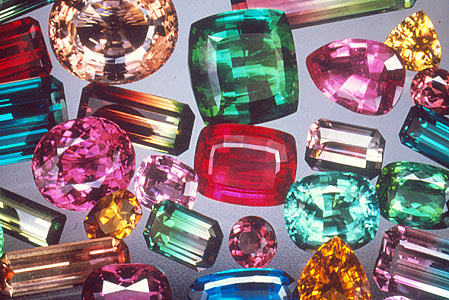
Tourmaline (Pronunciation: \'tur-mə-lən, -,lēn\)
Tourmalines are precious stones displaying a unique splendour of colours. According to an ancient Egyptian legend this is the result of the fact that on the long way from the Earth’s heart up towards the sun, Tourmaline travelled along a rainbow. And on its way it collected all the colours of the rainbow. This is why nowadays it is called the "Rainbow gemstone”.
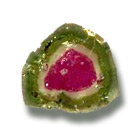 However, the name "Tourmaline” has been derived from the Singhalese expression "tura mali”, which translates as "stone of mixed colours.” The very name already refers to the unique spectrum of colours displayed by this gemstone, which is second to none in the realm of precious stones. Tourmalines are red and green, range from blue to yellow. Often they show two or more colours and are cherished for this parti- or multi-coloured appearance. There are Tourmalines which change their colour from daylight to artificial light, others display chattoyance. No Tourmaline exactly resembles another one: this gemstone shows many faces and is thus excellently suited to match all moods and tempers. It does not come as a surprise, then, that ever since ancient days it has been attributed with magical powers. Tourmaline is supposed to be an especially powerful influence on love and friendship, lending them permanence and stability.
However, the name "Tourmaline” has been derived from the Singhalese expression "tura mali”, which translates as "stone of mixed colours.” The very name already refers to the unique spectrum of colours displayed by this gemstone, which is second to none in the realm of precious stones. Tourmalines are red and green, range from blue to yellow. Often they show two or more colours and are cherished for this parti- or multi-coloured appearance. There are Tourmalines which change their colour from daylight to artificial light, others display chattoyance. No Tourmaline exactly resembles another one: this gemstone shows many faces and is thus excellently suited to match all moods and tempers. It does not come as a surprise, then, that ever since ancient days it has been attributed with magical powers. Tourmaline is supposed to be an especially powerful influence on love and friendship, lending them permanence and stability.
Colours, Names and Nicknames
In order to understand this multitude of colours you will have to polish up your knowledge of gemmology: Tourmalines are mixed crystals of complex aluminium-borosilicate varying in their composition. The slightest changes in composition will result in completely different colours. In fact, crystals showing one colour only are quite rare; generally one and the same crystal displays several shades and colours. Not only the wide range of colours characterises this gemstone, it also shows a remarkable dichroism. Depending on the angle of view the colour will be different or at least show different intensity. The deepest colour always appears along the main axis, a fact that the gemstone cutter has to keep in mind when cutting the stone. This gemstone is excellently suited for wearing and is uncomplicated to care for, since all Tourmalines show a hardness of 7 to 7.5 on the Mohs’ scale. Thus Tourmaline is an interesting gemstone in many aspects indeed.
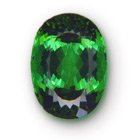 The different shades of colour have been assigned different names in the trade. For example, deep red Tourmaline is named "Rubellite”, provided it shows the same fine ruby-red shade in daylight and in artificial light. Should the colour change when the source of light changes, the stone will be called a "Pink Tourmaline”. Blue Tourmalines are called "Indigolith”, "Dravite” is a golden-brown to dark brown Tourmaline, and black Tourmalines are known as 'schorl"'Schorl'. The latter stone is mainly used for engravings and in esotericism, where it is highly cherished because it is reputed to ward off harmful radiation from its wearer.
The different shades of colour have been assigned different names in the trade. For example, deep red Tourmaline is named "Rubellite”, provided it shows the same fine ruby-red shade in daylight and in artificial light. Should the colour change when the source of light changes, the stone will be called a "Pink Tourmaline”. Blue Tourmalines are called "Indigolith”, "Dravite” is a golden-brown to dark brown Tourmaline, and black Tourmalines are known as 'schorl"'Schorl'. The latter stone is mainly used for engravings and in esotericism, where it is highly cherished because it is reputed to ward off harmful radiation from its wearer.
Very popular is "Verdelith”, the green Tourmaline, however, if its fine emerald-like green is caused by traces of chromium, the stone is named "Chromium-Tourmaline.” But the outstanding highlight among Tourmalines is of course Paraiba Tourmaline, a gemstone showing a vivid deep blue to bluish green, found for the first time in1987 in the mines of the Brazilian state of Paraiba. In good qualities these stones are much coveted treasures. Since yellow Tourmalines from Malawi of brilliant colour have been offered on the market, the formerly missing colour yellow has been added in excellent quality to the apparently unlimited range of colours shown by the "Rainbow Gemstone.”
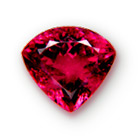
These are by no means all the names Tourmaline has achieved: there still have to be mentioned bi-coloured and multi-coloured Tourmalines Very popular are also slices cut as cross-sections through Tourmalines, as these will render the full splendour of colours embedded in a specific Tourmaline. For example, such slices taken from Tourmalines with red heart and green border are called a "Watermelon-Tourmaline”; slices with a clear heart and a black border are called "Moor’s head –Tourmaline”
Tourmalines are mined everywhere in the world. There are important occurrences in Brazil, in Sri Lanka and South and Southwest Africa. Other occurrences are situated in Nigeria, Zimbabwe, Kenya, Tanzania, Mozambique and Madagascar, Pakistan and Afghanistan. Tourmalines are also found in the USA, first of all in Maine and Utah. But although there are rich occurrences of Tourmalines all over the world, good qualities and fine colours are only rarely offered on the market. Therefore, then, the price range achieved by Tourmaline almost matches its wide range of colours.
The "Ashes-Extractor"
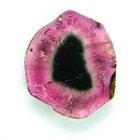 Not only designers are fascinated by Tourmaline because of its incomparable wealth of colours providing unlimited inspiration. Scientists are also intrigued due to its astonishing physical characteristics: by heating and subsequently cooling down Tourmalines will be charged up. The stone will then show positive charge at one end, and negative charge at the opposite pole. This is termed "pyro-electricity”, according to the Greek word "pyros" denoting fire. Pressure will also lead to the stone’s charging, and in the course of discharging the plus- and minus-poles will alternate, so that the stone will show vibrations similar to Rock Crystal, but much stronger. The Dutch, who originally brought Tourmaline to Europe, already knew about this effect long before it was subjected to scientific study. They used heated Tourmalines to extract the ashes from their meerschaum pipes and named the gemstone "Aschetrekker”.
Not only designers are fascinated by Tourmaline because of its incomparable wealth of colours providing unlimited inspiration. Scientists are also intrigued due to its astonishing physical characteristics: by heating and subsequently cooling down Tourmalines will be charged up. The stone will then show positive charge at one end, and negative charge at the opposite pole. This is termed "pyro-electricity”, according to the Greek word "pyros" denoting fire. Pressure will also lead to the stone’s charging, and in the course of discharging the plus- and minus-poles will alternate, so that the stone will show vibrations similar to Rock Crystal, but much stronger. The Dutch, who originally brought Tourmaline to Europe, already knew about this effect long before it was subjected to scientific study. They used heated Tourmalines to extract the ashes from their meerschaum pipes and named the gemstone "Aschetrekker”.
Tourmaline is a very special stone indeed and holds an outstanding position in the fascinating world of gemstones. Its excellent availability and unique splendour of colours make it one of the most popular gemstones – and besides almost every Tourmaline is an original.



